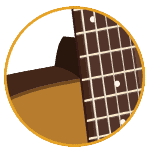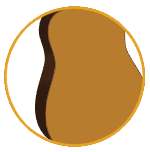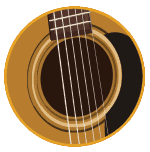The diagram shows the anatomy of an acoustic guitar. Some guitars may vary e.g. many classical and flamenco guitars will not feature a pickguard or truss rod but for the most part, the components listed below are common on all acoustic guitars. The sections below provide more information on each of the individual components.
![Anatomy of an Acoustic Guitar [Complete Guide] 2 Acoustic Guitar Anatomy](https://theacousticguitarist.com/wp-content/uploads/2018/09/anatomy-acoustic-guitar-2-1.jpg)
Headstock
![Anatomy of an Acoustic Guitar [Complete Guide] 3 Headstock](https://theacousticguitarist.com/wp-content/uploads/2018/09/headstock2.png)
All guitars feature a headstock (also called the ‘peg head’) which sits at the top of the guitar neck.
Its purpose is to provide a home for the tuning machines, a string termination point (one of the two main points at which strings are anchored on the guitar, the other being the bridge), define the break angle and space for the manufacturer’s branding.
Classical guitars and many 12-fret acoustic guitars feature slotted headstocks which feature a horizontal tuning mechanism, commonly seen on violas and violins.
When used on steel-string acoustic guitars the angle (break angle) the strings cross over at the nut is increased as the string is fixed at a lower point within the headstock, creating additional downward pressure which many believe increases sustain, clarity, and volume.
Headstocks usually come as ‘straight‘, ‘tilted‘, or ‘scarfed‘.
Straight headstocks are the least expensive to make as they utilize a single piece of wood. They do not apply as much downward pressure on the nut as a tilted headstock. Because of this, straight headstocks are rarely seen on high-end acoustic guitars. Most acoustic guitars feature tilted headstocks. A tilted headstock usually has a pitch of between 9 and 15 degrees. As mentioned above, the greater the pitch the more pressure is applied to the strings over the nut.
Scarfed headstocks are similar to titled headstocks, but are made from two pieces of wood. This often results in greater structural integrity.
Tuning Machines / Machine Heads

Tuning machines (also referred to as tuners, tuning pegs, or machine heads) are used to increase or decrease string tension when tuning the guitar.
Tuning machines are ‘geared’. This means they feature a cylindrical peg (tuning post) sitting inside a pinion gear. When the pegs are wound the tension increases or decreases on the individual string, depending on the direction turned.
The amount of tension applied per turn is measured as the ‘gear ratio’. A gear ratio of 12 to 1 means, that for every 12 turns of the tuning peg, the machine head cylinder turns 360 degrees. The higher the number, the more control you have over tuning.
Tuning machines come as either ‘sealed gear‘ or ‘open gear‘ variations. Acoustic guitars often feature ‘open gear’ tuners. Electric guitars tend to utilize ‘sealed gear’ tuners more often.
Nut

The nut is found at the headstock end of the guitar’s fretboard and is usually made from hard plastic, bone, or graphite (and in some cases brass).
Despite its small size, the nut plays a very important role. It is the string’s last point of contact before the tuning machines. Because of this, the nut transfers the vibration of the strings to the neck of the guitar. Along with the saddle, the nut also controls string spacing as all strings sit in slots cut into the nut of varying depths.
The nut slot depth is an important consideration. It differs based on the thickness of the string. For example, the low E string requires a deeper, wider nut slot than the high E string.
If the nut slot is too shallow the guitar string may come out of the slot. If the slot becomes too deep over time the string may come into contact with the fret wires causing fret buzz.
A nut slot cut too narrow can also contribute to tuning instability. This is because the string will not slide through the nut slot easily if additional tension is applied to the string, as in the case of performing a bend.
Neck

The guitar’s neck is home to the headstock, tuning machines, fingerboard (fretboard), inlays, and strings.
Necks are either fixed using glue (set neck) or bolted directly onto the body (bolt-on). In the case of acoustic and classical guitars, this is almost always a set neck, meaning it is glued in place.
The longer the neck, the longer the guitar’s scale length (the distance between the saddle and nut).
The wider the neck, the more area the fretboard utilizes. Generally, guitars manufactured to be played with the fingers e.g. classical and fingerstyle guitars feature a wider neck to provide more space between the strings (string spacing) making it easier to play individual strings.
Most steel-string acoustic guitars utilize a 43mm neck width, measured at the nut and commonly referred to as nut width. Classical guitars on the other hand will typically be over 50mm in width at the nut.
Necks also come in different depths (e.g. the thickness of the neck) and shapes (e.g. the roundness of the underside of the neck), known as the neck profile. (C, V, and U for example).
Frets and Fret wires

The frets of a guitar refer to the areas between the metal fret wires located on the fretboard, used to separate the guitar’s fretboard into semi-tone intervals.
Most acoustic guitars utilize between 18 and 20 frets, however, many electric guitars have up to, and sometimes beyond, 24 frets.
Fret wires are shaped like a mushroom or ‘T’ with the top section sitting on the fretboard and the stem (tang) embedded into the fretboard. The top of the fret wire is rounded to aid playability and is referred to as the crown.
Fret wires come in a variety of sizes, from tall, short, skinny, and wide. This chart shows the most available fret wires for guitars and other stringed instruments.
Fret wires can wear over time, particularly if the guitar is played regularly. When this occurs, frets may need to be replaced or repaired. This is known as fret dressing which involves leveling and reshaping (crowning) the top of the fret wire and may be performed as part of a guitar setup.
Fret Markers / Inlays

Fret Markers (also referred to as inlays or positional markers) are located on the guitar’s fretboard and indicate specific frets of the guitar’s neck. This allows the guitarist to orientate the guitar’s neck.
Typically guitar inlays will be found inset onto the 3rd, 5th, 7th, 9th, 12th, 15th, 17, 19, and 21st frets.
Inlays are seen in a variety of shapes, however, most are either square, trapezoid, or dots. In the case of dots, the 12th fret of the guitar usually contains two dots to indicate the octave.
Inlays are made from a variety of materials including, plastic, mother of pearl, and abalone to name just a few. Inlays are usually not seen on classical guitars, which typically only feature fretboard side dots.
Fretboard side dots are dots found on the side of the guitar fretboard at the same locations on the neck e.g. 3rd, 5th, 7th, 9th, 12th, 15th, 17, 19, and 21st frets.
Truss Rod

The truss rod is the metal tensioning bar running through the centre of the guitar’s neck that can be adjusted to modify the amount of relief or bow in the guitar’s neck.
The image to the left shows a cross-section image of the guitar neck, with a truss rod running through the middle of the neck.
Generally speaking, electric guitars and steel-string acoustics will require a truss rod however many classical guitars do not due to less tension being applied to the neck as nylon strings place less tension on the neck than steel strings.
Fretboard / Fingerboard

The fretboard (also referred to as the fingerboard) is the section of timber laminated onto the main area of the neck. It is usually manufactured from Rosewood, Ebony, or Maple (maple is more commonly seen on electric guitar fretboards and necks).
In the case of acoustic guitars, the fretboard has traditionally been Rosewood. For high-end classical guitars, the choice is often ebony. Rosewood is particularly popular as it is an oily timber, ideal for reducing tension between the fingers and fretboard, and is credited with contributing to a warmer tone.
CITES restrictions (Convention on International Trade in Endangered Species of Wild Fauna and Flora) placed on Rosewood from 2017 to 2019 were designed specifically to protect Indian Rosewood and forced manufacturers to explore engineered timber options and in most cases, these have shown great promise.
Update
The CITES restrictions on rosewood have undergone significant changes in recent years. In 2019, CITES decided to exempt finished musical instruments, parts, and accessories from restrictions on all rosewood species, except Brazilian rosewood, which remains protected.
Heel / Neck Joint

The heel (also referred to as the neck joint) is where the neck joins the body of the guitar, along with the sides of the guitar body.
For acoustic guitars, in most cases, the neck will be glued, using a dovetail joint, a particularly effective type of joint commonly used on acoustic guitars for hundreds of years.
Usually, acoustic guitar necks join the body at the 14th fret, but smaller body ‘parlor’ guitars, aka 12-fret guitars connect to the body at the 12th fret.
Back and Sides

The back and sides of an acoustic guitar are usually paired. Rosewood back and sides are often paired with Sitka or Adirondack Spruce tops.
The back and sides make up the stable elements of the body, with the soundboard or top wood being more flexible and as a result responsible for most of the projection of sound.
Lower Bout, Waist, and Upper Bout

Acoustic guitar bodies comprise an upper bout, which is the top half of the guitar, and a lower bout (the bottom half of the guitar). The bouts are separated by the waist, which is the narrow section located between the two bouts.
The body shape of an acoustic guitar influences the playability of the instrument and how comfortable the guitar is to play.
More importantly, the body shape and size influence the tone of the guitar as it affects the internal ‘air resonance’ of the guitar. For example, a wider lower bout lowers air resonance and gives more definition to the low-end tonal output of the guitar.
* Tone is influenced by many contributing factors. Body shape is just one of these.
Sound Hole

As the name implies, the soundhole is the hole located on the guitar’s soundboard.
In the majority of acoustic guitars, this is simply a circular shape but variations known as F-Holes are also seen in some acoustic guitars (mainly jazz acoustic/electric guitars and electric guitars).
Gypsy guitars (Selmer guitars) tend to have an elongated soundhole, while some manufacturers such as Bourgeois and Martin feature select guitars with larger than-normal sound holes.
Contrary to popular opinion the soundhole is not solely responsible for the guitar’s sound, which originates from the body of the guitar, in particular the soundboard, however, the soundhole opens up the body to facilitate the release of internal ‘air resonance’.
When covered, as is when using a soundhole cover to reduce feedback the volume isn’t reduced as much as many people might assume. However, if you fill the internal cavity of the guitar e.g. dampen the sound using a towel or similar item the volume is reduced.
Rosette

The rosette refers to the decorative rings located around the soundhole.
While the rosette may appear to be decorative only, rosettes also have a practical side to them and are used to reinforce the timber around the soundhole, which otherwise would be prone to absorbing moisture and cracking.
Pickguard / Scratch Plate

The pickguard (also referred to as the scratchplate) is located on the underside of the soundhole of the guitar body. As the name implies, the pickguard is used to ‘guard’ or protect the guitar’s body from the pick, which over time would otherwise scratch the guitar’s surface.
Pickguards are typically constructed from three separately laminated pieces of plastic (three-ply) and come in a variety of different shapes.
In the case of classical guitars, these are usually not used, as classical guitarists tend not to play with a pick. In the case of flamenco guitars, however, the pickguard is replaced with a clear protective plate referred to as the golpeador that protects the guitar‘s soundboard from the more aggressive strumming patterns flamenco music incorporates.
Binding

Binding refers to the strip (vinyl, PVC plastic, amongst other materials) that is seen on the joint between the top and sides of the guitar. It is also sometimes seen on the back of the guitar and the neck. If the neck features binding it is referred to as a bound neck.
Binding serves a few purposes. Firstly it provides a decorative element between the sides and the soundboard. Secondly, it protects the edges of the guitar which are most prone to impact, and also provides a smoother playing experience when applied to the neck.
You can read more about guitar binding here.
Soundboard

The soundboard is an essential part of the guitar‘s anatomy and refers to the top of the guitar’s body, which houses the bridge and soundhole.
Acoustic guitars rely on resonance to project sound. The soundboard vibrates due to the bridge being fixed to the soundboard which vibrates due to the guitar strings running directly over the saddle which is located in the middle of the bridge.
While the choice of timber is less critical on an electric guitar due to the additional components involved in creating tone, the choice of tonewood can play a major role in the acoustic guitar’s overall tone, resonance, and ultimately volume.
The wood used is selected for its strength and lightness. This is because the soundboard must vibrate freely to produce sound but also handle the tension applied by the steel strings. Soundboards also utilize bracing, to add additional tensile strength.
Bridge, Saddle, and Bridge Pins

The bridge is the part of the guitar that fixes the strings to the body and allows for the vibration from the strings to transfer to the body of the guitar, projecting sound.
Strings are typically fed through small holes in the bridge and locked in place by the bridge pins (also referred to as fixing pegs) which are pushed directly into the string holes, located on the bridge.
The bridge also features the guitar’s saddle, which is often made from the same material as the nut of the guitar.
Unlike the nut, however, the saddle is usually positioned on an angle with the end closest to the bridge pins reserved for the bass strings, allowing accurate intonation. Essentially the thicker strings e.g. ‘E’ and ‘A’ require slightly more length to compensate for their additional mass and subsequent tension when fretted due to their wider surface area.
Bracing – inside of acoustic guitar

Bracing refers to the wooden struts (structural components made from spruce, or a similar light yet strong timber) that reinforce the guitar‘s top and back.
Bracing supports these larger, lighter sections of timber structurally without adding much additional weight which would impact the guitars’ ability to resonate. Some struts are scalloped, which is a technique used to reduce the weight of the struts further while maintaining structural integrity.
![Anatomy of an Acoustic Guitar [Complete Guide] 4 Bracing the back of the guitar](https://theacousticguitarist.com/wp-content/uploads/2020/09/ladder-bracing.jpg)
There are many different types of bracing, including X-bracing which is the most common form of bracing among steel-string guitars. Classical guitars commonly utilize fan bracing.
Most guitar backs utilize ladder bracing, a simple form of bracing where the struts are fixed to a center strut and run perpendicular to the strings in much the same way as a ladder.
Summary
The components of the guitar referred to above are found in the majority of acoustic guitars. There are differences between models and manufacturers particularly regarding the headstock shape, tuning pegs, fretboard timber, fretboard wire gauge, rosette style, and material, inlay material, bridge design, and of course the tonewoods selected for the construction of the guitar. However for the most part the basic anatomy of an acoustic guitar will be similar across different models.
All of these differences account for the range of tones extracted from different acoustic guitars and the music they are most suitable for playing. This is just one of the reasons why owning one guitar is never enough.
If you enjoyed this article, you might also find my article on why acoustic guitars sound better with age interesting!
![Anatomy of an Acoustic Guitar [Complete Guide] 1 Acoustic Guitar Anatomy](https://theacousticguitarist.com/wp-content/uploads/2018/09/anatomy-acoustic-guitar-2.jpg)


